Modern technology is a double-edged sword. On the one hand, it makes many aspects of life much easier and far less labor intensive. For example, mechanized transport means it takes much less time to travel long distances and saves you from a whole lot of walking.
On the other hand, labor-saving devices mean that many people are so inactive that obesity is now a global epidemic, and the problem is compounded by easy access to high-calorie foods.
But, of the advancements over the years, the chair has probably caused the most problems.
While that might sound ridiculous, the chair really was the starting point for increased sedentarism, lower energy expenditure, and weight gain.
When you sit in a chair, almost all of your muscles can relax. The chair supports you. As such, you can remain in the same position for hours at a time. Many people spend almost all day sitting and only get up and walk to move from one chair to another and then to bed.
All this sitting does a number on your strength, mobility, posture, and flexibility. Some muscles get short and tight, while others get stretched and weakened.
Level Up Your Fitness: Join our 💪 strong community in Fitness Volt Newsletter. Get daily inspiration, expert-backed workouts, nutrition tips, the latest in strength sports, and the support you need to reach your goals. Subscribe for free!
Of all the muscles affected by prolonged sitting, your hamstrings tend to suffer the most.
Sitting with your knees bent for long periods means they shorten significantly. Unfortunately, because your hammies are involved with the function of your knees and hips, they can cause problems up and down your legs and even affect your lower back.
As such, most people need to work on their hamstring flexibility.
In this article, we reveal the best stretches for tight hamstrings. Do a few of these exercises daily to restore lost hamstring flexibility and improve knee, hip, and lower back function and health.
Hamstring Anatomy
While you don’t need to be an expert in anatomy and physiology to stretch your hamstrings, a basic knowledge of how these muscles work may help you determine which exercises are best.
So, feel free to skip this section if anatomy is not your thing or you are in a hurry to get to the stretching exercises!
Like the quadriceps, the hamstrings are a group of several individual muscles that work together. However, where the quads are made up of four muscles, the hamstrings are just three.
The three hamstring muscles are:
- Biceps femoris
- Semimembranosus
- Semitendinosus
The hamstrings are a biaxial muscle group, which means they cross two joints and have several functions. The hamstrings work together to extend your hip, flex your knee, and are also involved in hip and knee rotation.
During hip extension, the hamstrings work with the gluteus maximus, so many hamstring stretches also affect the glutes. Similarly, during knee flexion, the hamstrings work with the gastrocnemius, so you may feel some hamstring exercises in your calves.
The 7 Best Hamstring Stretches
To stretch your hamstrings, you need to take your hips into flexion, e.g., lean forward to touch your toes.
However, if the hamstrings are tight, you may find that your lower back starts to round as you hinge forward. Tight hamstrings are why a lot of people round their lower backs during squats and deadlifts.
So, while it may reduce your range of motion, you should take care not to round your lower back much when stretching your hamstrings. It not only gives a false impression of progress but rounding your lower back can also cause injury.
Similarly, avoid focusing too much on reaching for your toes when stretching your hamstrings. This tends to increase the rounding of the lower back. You can get a good hamstring stretch even if you don’t reach for your toes. Instead, focus more on hip flexion to effectively extend your hammies.
1. Supine single-leg hamstring stretch
The great thing about this stretch is that you do it lying on your back and in a relaxed position. This means it’s ideal for holding for extended periods, i.e., 60 seconds or more. Also, you won’t be able to round your lower back as you’ll be lying on it!
Stretching one leg at a time provides an opportunity to see if one leg is tighter than the other. If this is the case for you, repeat the stretch on your less flexible side to balance your legs.
How to do it:
- Lie on your back with your legs straight and arms by your sides.
- Lift one leg and reach up to hold behind your knee or around your calf. Keep your upper body on the floor. Your opposite leg can be bent or straight as preferred.
- Use your arms to gently pull your leg up and toward you.
- Hold this position for 20-60 seconds, increasing the stretch as your muscles relax.
- Lower your leg slowly to the floor, switch sides, and repeat.
Pro tip: If you can’t reach your leg, make things easier by looping a yoga strap or belt over your foot. Gently pull on the strap to deepen the stretch. This is a much better option than straining your upper body to reach your ankle or knee.
Level Up Your Fitness: Join our 💪 strong community in Fitness Volt Newsletter. Get daily inspiration, expert-backed workouts, nutrition tips, the latest in strength sports, and the support you need to reach your goals. Subscribe for free!
2. Seated hamstring stretch
While focusing one leg at a time is an excellent way to check if one hamstring is tighter than the other, it also means you need to spend twice as long stretching your hamstrings. This exercise stretches both legs simultaneously, so it’s much more time-efficient.
How to do it:
- Sit on the floor with your legs extended in front of you.
- Adopt a good posture with your torso upright and shoulders down and back.
- Leaning from your hips, hinge forward as far as you can. Don’t worry about trying to touch your toes. Instead, think about lowering your abdomen to your thighs.
- Hold this position for 20-60 seconds, increasing the stretch as your muscles relax.
Pro tip: If you find it hard to avoid rounding your lower back, sit on a low stool, yoga blocks, or even a folded cushion. Lifting your hips will reduce the tension in your hamstrings.
3. Standing single-leg hamstring stretch
This stretch is ideal for doing before a workout, e.g., you are about to go for a run. It’s also a good option if you want to stretch your hamstrings to break up long periods of sitting, e.g., at work or a long drive.
How to do it:
- Take a small step forward and bend your back knee slightly so your thighs are together. Place your hands on the thigh of your bent leg for support.
- Hinging from your hips, push your butt back and lean forward, lowering your chest toward your outstretched thigh. Try not to round your lower back.
- Hold this position for 20-60 seconds, increasing the stretch as your muscles relax.
- Stand up slowly, switch sides, and repeat.
Pro tip: Make this exercise even more effective by placing your heel on a step.
4. Wall hamstring stretch
This is a VERY relaxing way to stretch your hamstrings. The wall supports your legs so you can stretch your hamstrings for several minutes at a time. This is an excellent exercise for anyone with very tight hamstrings.
How to do it:
- Sit on the floor facing a wall. Place your feet on the wall and then shuffle your butt in, walking your feet up the wall as you do so.
- Try to get your butt all the way to the wall and straighten your legs. However, this may not be possible if your hamstrings are very tight, so just do your best.
- Hold this position for 20-60 seconds, increasing the stretch as your muscles relax.
- Deepen the stretch by placing the heel of one foot on the toes of the other, remembering to swap sides to stretch both legs evenly.
Pro tip: Stretch one leg at a time by doing this exercise next to an open doorway. Put the leg you want to stretch on the doorframe, and your other leg through the door, like this:
5. Forward fold
The forward fold is a yoga exercise that stretches the hamstrings and lower back. It also helps decompress your spine and increases blood flow to your upper body. However, unsupported forward flexion can also put a lot of stress on the lower back. Skip this exercise if you have a history of lower back pain.
How to do it:
- Stand with your feet together, legs straight, shoulders down and back, and look directly ahead.
- Hinging from your hips, lean forward as far as your flexibility allows. It may help to pull your stomach in as you descend.
- Reach down and place your hands on the floor in front of your feet. If you cannot reach, put your hands on your shins or even on your knees. Use your arms to provide gentle support.
- Breathing slowly throughout, maintain this position for 20-60 seconds, increasing the stretch as your muscles relax.
- Stand up slowly. The safest way to do this is to bend your knees and then stand up as though squatting. However, you can also hip hinge up if you have no back issues.
Pro tip: If you find this exercise hard to do with straight legs, bend your knees slightly and work on gradually straightening your legs as your flexibility improves. Stand next to a wall and rest your butt against it. Think about sliding your butt up the wall.
6. Chair hamstring stretch
As sitting in chairs is the leading cause of hamstring tightness, it’s only right that we include a hamstring stretch you can do while sitting in a chair! This is an excellent stretch for breaking up long periods of inactivity.
How to do it:
- Sit on the edge of your chair with your legs bent to 90 degrees and your feet flat on the floor. Adopt a tall posture with your torso upright and shoulders down and back. Look straight ahead.
- Extend one leg out in front of you so your knee is straight and your heel is resting on the floor.
- Place your hands on your bent knee for support.
- Leaning from your hips, hinge forward and lower your chest toward your outstretched leg.
- Hold this position for 20-60 seconds, increasing the stretch as your muscles relax.
Switch sides and repeat.
Pro tip: Set the alarm on your phone and do this stretch every hour or so to offset some of the negative effects of prolonged sitting.
7. Foam rolling the hamstrings
Your muscles are surrounded by a thin layer of fibrous tissue called fascia. Fascia separates and connects each muscle from its neighbor. This fascia can become “gummed up,” leading to tight, painful muscles. This can cause trigger points, poor blood flow, and reduced function.
Foam rolling is a form of self-massage called self-myofascial release that can help free up your fascia and restore normal movement and function. Foam rolling your hamstrings will enhance knee and hip joint mobility and performance.
How to do it:
- Sit on the floor with your legs extended. Place your roller behind your knees. Support your weight by placing your hands just behind your hips.
- Using your arms, lift your butt a few inches off the floor and then roll from the backs of your knees to just below your glutes.
- Spend extra time on any areas of tightness you encounter.
- Continue rolling up and down your legs for 3-5 minutes.
Pro tip: Get a stronger, deeper effect by bending one leg and putting all your weight on one hamstring at a time.
More Stretches:
- Don’t Just Sit There! 8 Useful Things to Do Between Sets in The Gym
- Essential 6-Minute Stretching Sequence for Immediate Muscle Relief
- Partner-Assisted Stretching: Just Lazy or the Key to Optimizing Your Flexibility?
- Age-Proof Your Body: The Ultimate Guide to Exercises That Prevent Mobility and Muscle Loss
- Unlock Your Hip Flexors: Assisted Prone Lying Quads Stretch Guide
- 10 Best Abs Stretches to Improve Flexibility
- Say Goodbye to Stretching: Relieve Upper Body Tension with This 10-Minute Foam Rolling Routine
- How a 2-Minute Hanging Habit Transforms Your Body (Science Explained)
Hamstring Stretches – Wrapping Up
Most people should be able to achieve 90 degrees of hip flexion without undue stress. If you can’t comfortably touch your toes with your legs straight and without excessively rounding your lower back, your hamstrings are probably too tight.
Tight hamstrings can affect your knees, hips, and spine and could even prevent you from squatting or deadlifting correctly. Short, tense hamstrings are also more prone to injury, especially during dynamic activities such as lifting, sprinting, and jumping.
Unfortunately, prolonged sitting means that many people have chronically tight hamstrings.
The good news is that the hamstrings are easy to stretch and are very responsive to regular flexibility training. Work on your hamstrings every day to restore lost mobility. Better yet, stretch them several times a day to improve muscle elasticity even quicker.

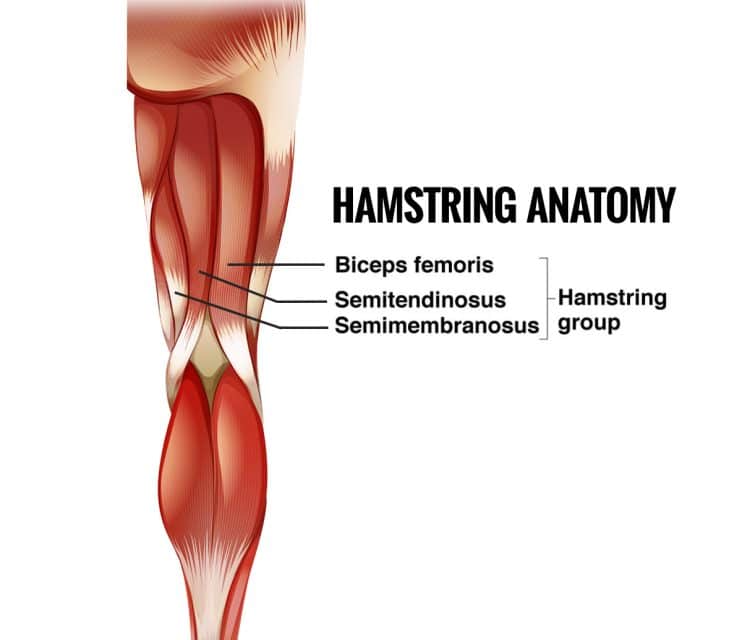

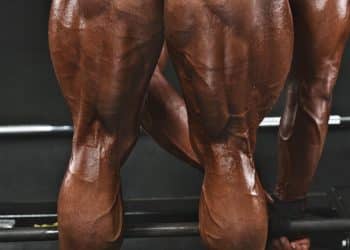
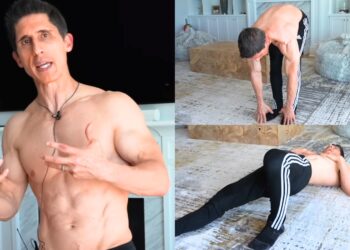


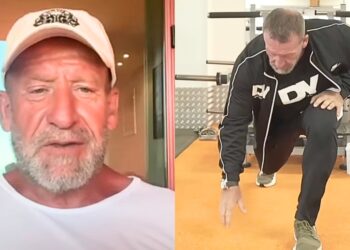
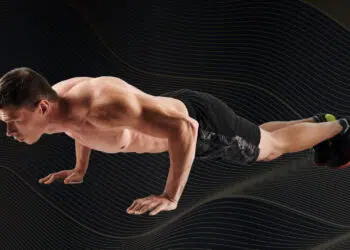

Sitting really does mess with your health. Ironically almost everyone reading this will be doing it sat down! It’s very hard to avoid. I try and stand up every 30 minutes at work, but my boss thinks I’m nuts!
Sounds like a good plan! I set a timer to go off every 25 minutes and then move/stretch for five minutes. It’s called the pomodoro method and it’s also a productivity tool. Try it – if your boss will let you, that is 🙂